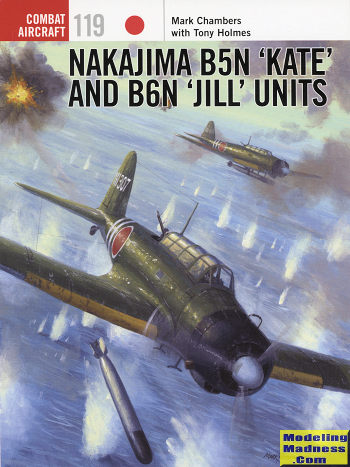 One
could easily make a case that the Nakajima B5N, later code named 'Kate', was the
best naval carrier based torpedo bomber of its time. It certainly had everything
that the IJN needed; it was relatively fast, had great range, carried the
world's best aerial torpedo, and was capable of performing level bombing and
reconnaissance as well. While initial production models were lacking in engine
power, the modified version that was built in the greatest numbers, had an
improved and more powerful engine.
One
could easily make a case that the Nakajima B5N, later code named 'Kate', was the
best naval carrier based torpedo bomber of its time. It certainly had everything
that the IJN needed; it was relatively fast, had great range, carried the
world's best aerial torpedo, and was capable of performing level bombing and
reconnaissance as well. While initial production models were lacking in engine
power, the modified version that was built in the greatest numbers, had an
improved and more powerful engine.
The aircraft quickly supplanted biplane torpedo aircraft and even though
Mitsubishi produced a short run of similar planes, it was deficient in almost
all categories as the Nakajima plane so production was quickly halted.
Initially operated in the war with China, it was paramount in the
success at Pearl Harbor and at several other early naval battles against the US
fleet. However, the Kate had its issues. In order to produce its superb range
and its speed, it lacked decent armor protection for its crew or its fuel tanks.
This meant that when it was successfully attacked, it easily caught fire or had
its crew killed.
As the war progressed, the Kate edged towards obsolescence, but Nakajima
was working on a replacement. This was the B6N, code named Jill. Every aspect of
the earlier plane was improved. It had more power, greater range, protection for
fuel tanks and crew, but by the time it entered service, the war situation had
changed. Gone were most of the experienced crew. Allied (as in US) airpower was
very strong and the plane simply could not operate efficiently in the threat
environment of the time. Like the Kate, many Jill airframes were expended in
suicide attacks in the last year of the war, never able to fully operate as
intended.
In this book, the authors cover the history and development of both
types as well as the various campaigns in which they were utilized. Not
surprisingly, most of the photos taken of these planes are either post war or
ones from the vessels they were attacking. Apparently the Japanese did not
photograph the planes a lot or if they did, most were destroyed in the mass
record destruction that occured at the end of the war. The book does include
several pages of superbly done color profiles that are most welcome and a
feature of this series. It is an interesting look at these types and their
battle history. A book that fans of WWII Japanese planes really need to have on
their reference shelves.
June 2017
Copyright ModelingMadness.com. All rights reserved.
For more on the complete line of Osprey books,
visit www.ospreypublishing.com
If you would like your product reviewed fairly and
fairly quickly, please
contact the editor or see other details in the
Note to
Contributors.
 One
could easily make a case that the Nakajima B5N, later code named 'Kate', was the
best naval carrier based torpedo bomber of its time. It certainly had everything
that the IJN needed; it was relatively fast, had great range, carried the
world's best aerial torpedo, and was capable of performing level bombing and
reconnaissance as well. While initial production models were lacking in engine
power, the modified version that was built in the greatest numbers, had an
improved and more powerful engine.
One
could easily make a case that the Nakajima B5N, later code named 'Kate', was the
best naval carrier based torpedo bomber of its time. It certainly had everything
that the IJN needed; it was relatively fast, had great range, carried the
world's best aerial torpedo, and was capable of performing level bombing and
reconnaissance as well. While initial production models were lacking in engine
power, the modified version that was built in the greatest numbers, had an
improved and more powerful engine.